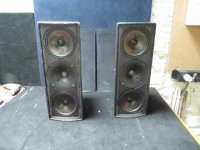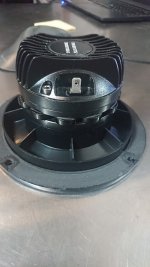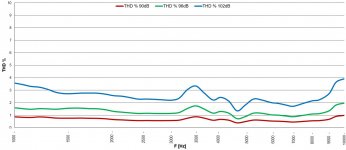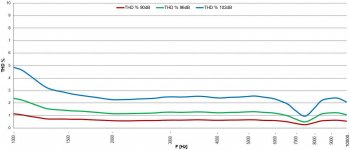Comparing Fulcrum's FH and AH Coaxial Horn Systems - YouTube
Fluid I wanted to show you this, your project reminded me of this....haven't seen anyone 3d printing phase plug for large woofers yet.
Fluid I wanted to show you this, your project reminded me of this....haven't seen anyone 3d printing phase plug for large woofers yet.
Sorry but in my book that's not good at all.On-axis it ain't pretty, but even slightly off-axis it's very good and approaches CD.
Perfect for a XO @ 1800 Hz.
Thanks for that link. More and more SynAudCon is turning into my go-to site for practical audio science.
On that page you linked, was this link to a 1979 SynAudCon session with Dick Heyser. What a genius !!
Richard Heyser on TDS | Prosoundtraining
just finished the full 5hrs...
Asolutely Mark, for years SynAudCon has been one of my favorite audio related websites.
No BS, only science-based know-how, field tested and aimed at a professional audience.
Sorry but in my book that's not good at all.
That reaction was to be expected 😛
Imho the curve that is most relevant in daily practice (in an average living room) is 30°. Earlier in this thread, the comparison of the JBL M2 to the Revel Salon2 was cited. The latter is also not perfect CD in the high midrange and top octave, but is still preferred by the public. Apparently, other factors are equally, or even more important, besides DI.
According to Kevin Voecks:
"...the "listening window" is the most useful measurement of the direct sound. It is comprised of 10, 20, and 30° horizontal off-axis measurements, and ±10° vertical measurements."
Btw, the particular tweeter I referred to was also recommended by Pet007 on a local forum.
It crushes the only Bliesma tweeter I'd consider buying, the T25S-6, at 35% of the price.
Last edited:
For those who consider building a small system, comprised of (multiple) 6.5" or 8" drivers + comp. driver, horn loading is irrelevant and thus a very shallow waveguide can be used.
Attachments
Last edited:
On that page you linked, was this link to a 1979 SynAudCon session with Dick Heyser. What a genius !!
The anthology of the genius' works on measurement, analysis, and perception is "open access" on AES.

Sometimes it's nice to get a backup of one of the greats when it comes to certain views.
“Perhaps more than any other discipline, audio engineering involves not only purely objective characterization but also subjective interpretations. It is the listening experience, that personal and most private sensation, which is the intended result of our labors in audio engineering. No technical measurement, however glorified with mathematics, can escape that fact.”
Last edited:
An example of (BS) marketing-induced nonsense engineering versus high quality / price ratio.
Left is the ScanSpeak ellipticor tweeter. Right is the tweeter I referred to, which costs less than 6.5% of the SS (yes, you read that correctly).
Assuming that both tweeters are deployed around 2 kHz and should be able to play loud, THD in the upper midrange and treble is most relevant to the perceived sound quality.
Left is the ScanSpeak ellipticor tweeter. Right is the tweeter I referred to, which costs less than 6.5% of the SS (yes, you read that correctly).
Assuming that both tweeters are deployed around 2 kHz and should be able to play loud, THD in the upper midrange and treble is most relevant to the perceived sound quality.
Attachments
Last edited:
Respectfully, I'm not sure that THD as a measure of SQ is something we should get into in this thread. I know of no new scientific evidence to support or refute it since the last time it was discussed to death, or the time before that.
Last edited:
Agreed, my point was to give an example of the futility of some "exotic" drivers and it ends right here 😉
(The rising THD > 8 kHz is most likely related to modes / IMD due to the elliptical dome, which should affect SQ)
(The rising THD > 8 kHz is most likely related to modes / IMD due to the elliptical dome, which should affect SQ)
Last edited:
A final addition.
According to A. Voishvillo:
"THD is a lower resolution measure of nonlinearity, but can still be used for the comparison of loudspeakers of the same type."
According to A. Voishvillo:
"THD is a lower resolution measure of nonlinearity, but can still be used for the comparison of loudspeakers of the same type."
Sorry but in my book that's not good at all.
I have that tweeter and it isn't CD and doesn't approach it. All dome tweeters would "approach CD" in a similar way, which simpy doesn't make any sense.That reaction was to be expected 😛
M2 is not perfect either.Earlier in this thread, the comparison of the JBL M2 to the Revel Salon2 was cited. The latter is also not perfect CD in the high midrange and top octave, but is still preferred by the public.
I already expressed my opinion about the reasons.Apparently, other factors are equally, or even more important, besides DI.
Thanks for the link.The anthology of the genius' works on measurement, analysis, and perception is "open access" on AES.
Here is one useful quote from that work regarding the previous debate about group delays ("SOME USEFUL GRAPHICAL RELATIONSHIPS", p.105):
"[...] Rule 2 ii) is a very interesting consequence of the Hilbert transform graphical relationships. The negative of the derivative of the phase response as a function of frequency is approximately proportional to the amplitude response. This means that group delay [3] measurements and amplitude measurements will be look-alikes if you are measuring a minimum-phase system. If you have plots of group delay and amplitude response, you can instantly tell whether the device being measured is minimum phase."
That's what I've been saying all along - that the magnitude response and the group delay is virtually one and the same thing for a minimum-phase device. There's no reason to examine the group delay per se. To examine whether is the system minimum-phase or not we need to know how is the phase response different from the minimum one. That's what the presented "excess group delay" plots show.
It would be interesting to see if there's some excess phase (leading to excess group delay) measurable in a very "bad" horn or not. Unfortunately I don't posses any such device. From the data I have on some of the "better" devices it seems that all the HOMs will be very low level - too low to detect them by a typical pressure measurement.
Last edited:
Sandhorn measured with Beyma CD11Nd, raw and normalized (courtesy of BV) -
What is the size of the sandhorn?
EDIT: Ok now I see, 336 mm
Attachments
Last edited:
Today I found P.Audio PH-220 in the cellar 🙂[...] It would be interesting to see if there's some excess phase (leading to excess group delay) measurable in a very "bad" horn or not. Unfortunately I don't posses any such device. From the data I have on some of the "better" devices it seems that all the HOMs will be very low level - too low to detect them by a typical pressure measurement.
That's more or less an H100 clone, which is definitely not a very bad horn.
I'd recommend to buy an original H100 though, because of the material properties, the surface finish and roundovers.
Looking forward to your findings nonetheless.
It is certainly interesting to investigate to what extent the - scientifically demonstrable disadvantages - of a diffraction slot actually influence the (midfield) rendering.
The 2380A should be an example of a "bad horn," but it is precisely this one that is used in, what many professionals consider, one of the very best studio monitors ever made.
The maker (Jürgen Strauss) is extremely focused on impulse / phase and radiation characteristics.
According to the pro's in the recording business, despite the analog technology, the MF-2 is superior to it's (FIR optimised) competitors.
Also interesting is Strauss's view that separate subs are a big no-go in a stereo studio setup.
I'd recommend to buy an original H100 though, because of the material properties, the surface finish and roundovers.
Looking forward to your findings nonetheless.
It is certainly interesting to investigate to what extent the - scientifically demonstrable disadvantages - of a diffraction slot actually influence the (midfield) rendering.
The 2380A should be an example of a "bad horn," but it is precisely this one that is used in, what many professionals consider, one of the very best studio monitors ever made.
The maker (Jürgen Strauss) is extremely focused on impulse / phase and radiation characteristics.
According to the pro's in the recording business, despite the analog technology, the MF-2 is superior to it's (FIR optimised) competitors.
Also interesting is Strauss's view that separate subs are a big no-go in a stereo studio setup.
Last edited:
What's so great about it?...one of the very best studio monitors ever made.
It seems the question "What's not so great about it?" is more appropriate.
You should ask the people who work with these, or the AES Swiss Section.
I've yet to come across a negative comment on these beasts.
Unfortunately, it's impossible to get hold of measurement data.
You should ask the people who work with these, or the AES Swiss Section.
I've yet to come across a negative comment on these beasts.
Unfortunately, it's impossible to get hold of measurement data.
Last edited:
- Home
- Loudspeakers
- Multi-Way
- Acoustic Horn Design – The Easy Way (Ath4)



